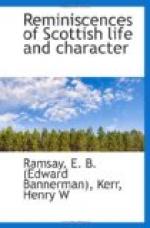FOOTNOTES:
[42] Bear.
[43] Rev. R. Scott of Cranwell.
[44] I have derived some information from a curious book, “Kay’s Portraits,” 2 vols. The work is scarcely known in England, and is becoming rare in Scotland. “Nothing can be more valuable in the way of engraved portraits than these representations of the distinguished men who adorned Edinburgh in the latter part of the eighteenth century.”—Chambers.
[45] Origin and Progress of Language.
[46] Douglas’ Peerage, vol. i. p. 22.
[47] The version I have given of this amusing burlesque was revised by the late Mr. Pagan, Cupar-Fife, and corrected from his own manuscript copy, which he had procured from authentic sources about forty years ago.
[48] His Lordship usually pronounced I am—Aum.
CHAPTER THE SIXTH.
ON HUMOUR PROCEEDING FROM SCOTTISH EXPRESSIONS, INCLUDING SCOTTISH PROVERBS.
We come next to Reminiscences which are chiefly connected with peculiarities of our Scottish LANGUAGE, whether contained in words or in expressions. I am quite aware that the difference between the anecdotes belonging to this division and to the last division termed “Wit and Humour” is very indistinct, and must, in fact, in many cases, be quite arbitrary. Much of what we enjoy most in Scottish stories is not on account of wit properly so called, in the speaker, but I should say rather from the odd and unexpected view which is taken of some matter, or from the quaint and original turn of the expression made use of, or from the simple and matter-of-fact reference made to circumstances which are unusual. I shall not, therefore, be careful to preserve any strict line of separation between this division and the next. Each is conversant with what is amusing and with what is Scotch. What we have now chiefly to illustrate by suitable anecdotes is peculiarities of Scottish language—its various humorous turns and odd expressions.




